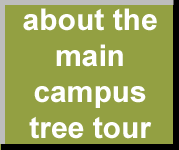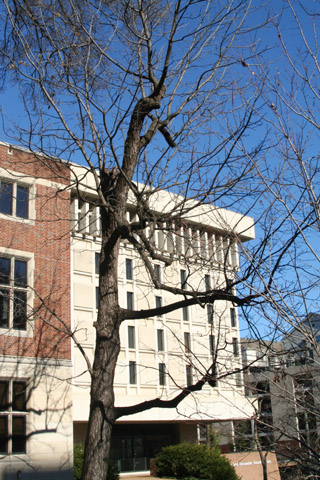 |  |  |  |
An individual instance of Juglans nigra (black walnut)

Permanent unique identifier for this particular organism:
http://bioimages.vanderbilt.edu/vanderbilt/6-85
Notes:
This medium-sized tree grows along the library side of the sidewalk near the corner of the older part of the central library building. It is near where the sidewalk from Frist and Godchaux Halls meet the sidewalk along the side of the library.
Black walnut leaves are one of the largest singly pinnate (leaflets arranged along a single central rachis) leaves in this area. Trees with similar leaves are tree of heaven and pecan. Later on this tour you will have an opportunity to compare another walnut tree with a tree of heaven nearby. The leaflets of tree of heaven have a distinctive gland in a notch at the base of each leaflet. Walnut leaflets do not have this gland. Walnut twigs also have unusual chambered pith (please do not cut branches or twigs from trees on the Vanderbilt campus) and tree of heaven twigs do not. This large walnut tree shows the distinctive furrowed bark of walnut, which is quite different from the smoother bark of tree of heaven. Pecan trees are not common in the wild in this area so they aren't likely to be confused with walnut there. Pecan bark is also not deeply furrowed and its twigs do not have chambered pith.
If the fruits are present, these three trees can't be confused. Walnuts are very hard, round, and surrounded by a thick husk that doesn't split along any particular lines. In the fall, this particular tree usually has fruits hanging on the branches at eye level or on the ground beneath it. Pecans are oblong with a thinner shell and when ripe, their husks splits fairly easily into several pieces. Tree of heaven fruits are not nuts but rather are thin and winged.
Black walnut trees are fairly common in forests in this area, although large trees are somewhat rare because they are frequently cut for their valuable wood.
Black walnut leaves are one of the largest singly pinnate (leaflets arranged along a single central rachis) leaves in this area. Trees with similar leaves are tree of heaven and pecan. Later on this tour you will have an opportunity to compare another walnut tree with a tree of heaven nearby. The leaflets of tree of heaven have a distinctive gland in a notch at the base of each leaflet. Walnut leaflets do not have this gland. Walnut twigs also have unusual chambered pith (please do not cut branches or twigs from trees on the Vanderbilt campus) and tree of heaven twigs do not. This large walnut tree shows the distinctive furrowed bark of walnut, which is quite different from the smoother bark of tree of heaven. Pecan trees are not common in the wild in this area so they aren't likely to be confused with walnut there. Pecan bark is also not deeply furrowed and its twigs do not have chambered pith.
If the fruits are present, these three trees can't be confused. Walnuts are very hard, round, and surrounded by a thick husk that doesn't split along any particular lines. In the fall, this particular tree usually has fruits hanging on the branches at eye level or on the ground beneath it. Pecans are oblong with a thinner shell and when ripe, their husks splits fairly easily into several pieces. Tree of heaven fruits are not nuts but rather are thin and winged.
Black walnut trees are fairly common in forests in this area, although large trees are somewhat rare because they are frequently cut for their valuable wood.
 |  |
Load database and switch to thumbnail view
Use this stable URL to link to this page:
http://bioimages.vanderbilt.edu/vanderbilt/6-85.htm
This organism is a living specimen that is part of the Vanderbilt University Arboretum with the local identifier 2-502.
This particular organism is believed to have managedmeans of establishment.
This organismal entity has the scope: multicellular organism.
Identifications:
Juglans nigra
L.
sec. fna.org 1993
common name: black walnut
family: Juglandaceae
Identified 2002-04-22 by Steven J. Baskauf
Location:
Vanderbilt University, Nashville, Davidson County, Tennessee, US
Click on these geocoordinates to load a map showing the location: 36.14539°, -86.80022°
Coordinate uncertainty about: 10 m.
Location of individual determined from GIS database.
Occurrences were recorded for this particular organism on the following dates:
2002-04-22
2003-09-30
2013-12-11
2014-09-03
The following images document this particular organism.
Click on a thumbnail to view the image and its metadata.Load database and enable navigation by taxon and organism.
| Image | View |
 | whole tree (or vine) - general |
 | whole tree (or vine) - winter |
 | twig - unspecified |
 | inflorescence - whole - unspecified |
 | inflorescence - whole - male |